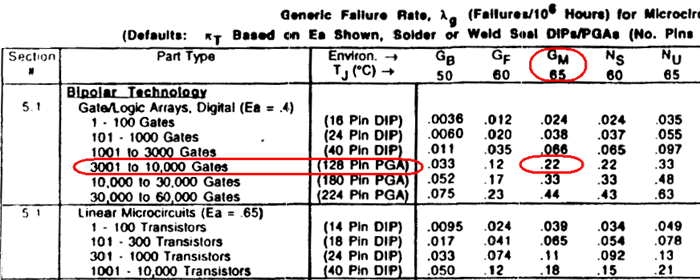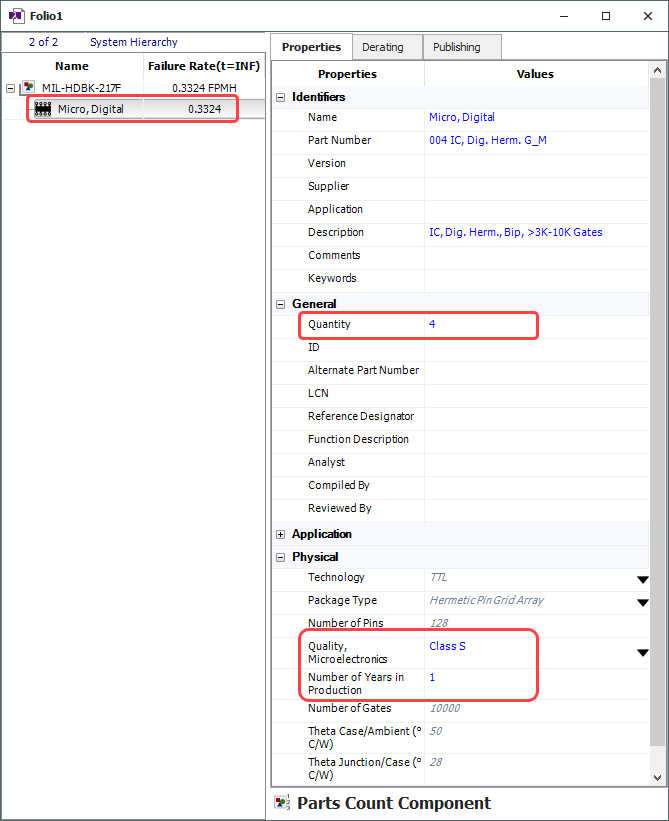Using the Parts Count Method
In addition to providing full support for the MIL-217 part stress calculation method, Lambda Predict can also be used to create a MIL-217 parts count prediction. This analysis approach may be applicable during bid proposals and early design phases when sufficient information is not available to use the part stress method.
In a parts count folio, you can build the system configuration only by importing components from Lambda Predict's "PartsCount.lplib21" library file, and you can only edit the properties that are relevant for the parts count method. This restricts your analysis to the rules of parts count prediction, helping you to eliminate potential errors that may occur as a result of mixing part stress and parts count components.
For parts count analyses that were created in previous versions of Lambda Predict, we recommend rebuilding the prediction in a new parts count folio. If you want to keep the analysis in the standard prediction folio, see Performing a Parts Count Analysis in a Standard Prediction Folio.
Tip: You can use the Import Local Components command to import individual components from a parts count folio into a standard prediction folio for part stress analysis, if desired. Alternatively, you can export the entire system hierarchy to an Excel worksheet (see Creating Reports), and then import the data into a standard prediction folio (see Import Bill of Materials).
Parts Count Library File
Lambda Predict’s "PartsCount.lplib21" library file is installed with the software and saved in the default documents folder for your computer (e.g., My Documents\ReliaSoft\Lambda Predict 21\Libraries). It contains the default failure rates for the MIL-217 components covered in Appendix A of the MIL-HDBK-217F handbook. For identification purposes, each component in the library file is identified by a part number that includes a component number, a short description of the component and an environment designation. For example, the library file uses the following part number for a bipolar gate/logic array with 4,000 gates:
004 IC, Dig. Herm.
where:
- 004 represents the component number. This number is unique for each component type in the library file.
- IC, Dig. Herm is short for "Integrated Circuit, Digital. Hermetic."
- G_M stands for "Ground, Mobile" environment.
This component corresponds to the item described in Section 5.1 of Appendix A, as shown below.

Example
Assume you have four digital bipolar gate/logic arrays with 4,000 gates of Class S quality that have been in production for one year and will be operating in a Ground, Mobile environment.
To import this component for use with the parts count method, follow these steps:
- Create a MIL-217 parts count analysis folio by choosing Home > Insert > Prediction Folio, and then selecting the MIL-HDBK-217F (Parts Count) standard in the setup window.
-
In the prediction folio, select the MIL-217 standard item
 , and then choose System Hierarchy > Local Components > Import Local Components.
, and then choose System Hierarchy > Local Components > Import Local Components.
![]()
- In the Import Local Components window, select the Library option and make sure that the PartsCount.lplib21 library file is selected. Enter the search criteria as shown in the following picture (the search is not case sensitive), and then click the Search button.

In the table of results, select the component and then click Add to import it into the current prediction folio. Click Close to return to the folio.
-
In the prediction folio, update the value of the following component properties:
- Quantity = 4
- Quality = Class S
- Number of Years in Production = 1
The system hierarchy shows that the calculated failure rate for the component, based on the parts count method, is 0.3324 FPMH, as shown next.

Performing a Parts Count Analysis in a Standard Prediction Folio
Although we recommend using the new parts count folio for parts count analysis, it is still possible to perform the analysis in a standard prediction folio. This allows you to continue working with existing parts count analyses that were imported from previous versions of Lambda Predict.
There are two things to keep in mind when performing parts count analysis in a standard prediction folio:
-
The parts count prediction method is based on the generic failure rates of components that were calculated using certain default parameter values. Based on this rule, only the following information may be modified for each component you import from the parts count library file. If you edit the value of any fields other than those listed below, the analysis will be treated as a part stress prediction rather than a parts count prediction.
- Quantity
- Part type
- Part quality level
- Equipment environment
- Number of years in production (for microcircuits only)
-
Coils and mechanical relays use different quality factors in a parts count analysis compared to the values used for a parts stress analysis. If you are performing the parts count analysis in a standard prediction folio, you must use the Adjustment Factor field instead of the Quality field for those components.
For coils, use the following values for the adjustment factor:
| MIL-217 Quality | Set the Adjustment Factor to: |
| Established Reliability | 0.25 |
| MIL-SPEC | 1.0 |
| Non-MIL (low quality) | 3.0 |
For mechanical relays, use the following values:
| MIL-217 Quality | Set the Adjustment Factor to: |
| Established Reliability | 0.6 |
| MIL-SPEC (non-established reliability) | 1.5 |
| Non-MIL (commercial or unknown) | 2.9 |